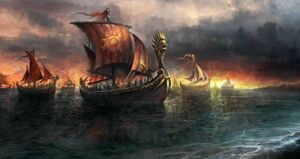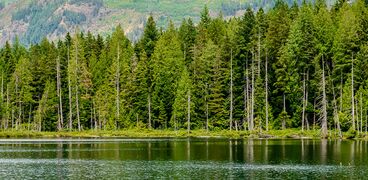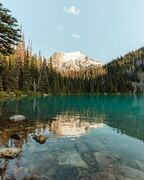Cao
Script error: The module returned a nil value. It is supposed to return an export table.
Cao Special Federal District 花岛 | |
|---|---|
Subject of the Democratic Republic of Corumm | |
| Special Subject | Corumm |
| Capital and largest city | Kogorun |
| Official languages | Corummese |
| Government | |
• District Chief | Lei Shen |
Cao, officially the Cao Special Federal District is a territory owned by Corumm that sits near the entrance to the Sea of Nysdra in northern Crona. It consists solely of the island of Cao and its adjacent territorial waters. Its capital and the largest population center is the city of Kogorun. The island's population is approximately 1.2 million inhabitants. The island's command of the gateway to the Nysdra make it a highly strategic location and an important economic hub for all of north Crona. It also serves as the base for the Corummese navy's Nysdra squadron with responsibility for safeguarding Corummese lines of communication to Xisheng open.
Geography and Climate
Oceanic cool climate or something
-
Cao's coastline
-
Forested area outside Kogorun
-
Mount Totoro
History
Pre-Corummese era

Starting in the 1200's the island of Cao was colonized by a separate polity called the Axolotl who named the island, Uxma. The Axolotl were closely related with the Mixcala tribe which would later wholly join the Northern Confederation on the mainland, the cause for the separation is not a topic well explored by historians. The Axolotl repelled several Mixcalan attempts at reintegration through force and as a result of these attacks became involved in piracy as a form of retaliation. Raiding the Mixcala and their neighbouring tribes as well as the coasts of Quetzenkel, the Axolotl became a regular plague upon local trade, with plunder and slaves becoming a mainstay of the local economy. Many of the slaves taken by the pirates of Uxma ended up sold in the bazaars of Varshan, and Varshanis were allowed to join pirate ships as crewmen. Several attempts at quashing piracy were made in the early 1500's, most notably by Quetzen chiefdoms, and they succeeded in temporarily curbing the raids.
During this period the island seems to have been directly ruled by the four strongest captains, who convened into the Council of High Captains to apportion trade routes, discuss common defense and settle disputes. Over time the position of High Captain became a hereditary one, passing from fathers to sons. It could also be inherited by killing the previous holder of the office. The Axolotl raids also seemed to have included a religious component to them as a certain proportion of a captured ship's crew would always be taken to be used in distorted M'acunism's rituals. Records sporadically show the existence of a 'High Celebrant' who appears to have been a position of great religious significance and also political influence, eclipsing the pirate council at times.
Settlement era
Corummese exploration in the late 1500's brought them to the gates of the Nysdra and Uxma. In 1504 the ship Shin's Pleasure carrying Zhong dynasty officials on an official embassy to the Quetzenkel chieftains, was set upon by Uxma pirates. The boarding attempt was repelled with heavy casualties on both sides and Shin's Pleasure left the area and headed back southwest. News of the brazen attack left a powerful impression back at the Zhong court and a punitive expedition was dispatched. Consisting of ten ships armed with cannons and with close to twelve-hundred men, it was the largest naval show of force by the Corummese that moved so far north. A numerically superior pirate force was defeated; with two High Captains killed, by the Corummese at the Battle of the Straits before moving on to attack Uxma itself. After a short bombardment and siege Uxma surrendered to the Corummese, with the two remaining High Captains fleeing with a few ships.
Modern era
modern era stuff, role in war, varshan shelling of island, disputes over maritime borders with urcea
Demographics
Ethncity according to the official census (2020)
The Special Federal District of Cao has a mostly homogenous Corummese majority derived from centuries of pro-colonization policies and ethnic cleansing. Some Corummese have intermixed with locals giving rise to a group of more swarthy and stocky looking Island-Corummese. Of the original Axolotl inhabitants there remains a small, extant population that does not exceed ten percent of the island's total. Small numbers of descendants of slaves from local nations such as Varshan and Quetzenkel also exist, usually living in precarious economic situations and indigency. The Varshani component is expected to rise with the possible resettlement of more Varshanis after the end of the wars of the Deluge, but with an accompanying strict implementation of natality controls.
Rusani settlement was also allowed and even nurtured as in the past the ethnicity served to create an extra layer of contact between the Corummese and locals. Rusani are typically found in the lower bureaucracy and as small business owners. There are three mosques on the island available for practicing Rusani muslims, the International Friendship Masjid in Uxma-2, the Abu Molokas Mosque in Moloka and the Center of Islamic Study in Kogorun. Racial intermixing was strictly banned until 1998 when controls were loosened, though it is still looked down upon and discouraged by most Corummese families. The island's society has a clear cut stratification of its ethnic groups with the Corummese at the top followed by the Rusani and Axolotl, Varshanis and Quetzi occupy the lower rungs of the social pyramid.
Economy

The island's economy revolves around fishing, shipping and manufacturing and industrial operations in addition to the dockyards operated by the Corummese Navy. Due to the limited availabily of land, there is only small scale agriculture in the form of hydroponics and most of the food is imported from Kiravian Porfíria or from Xisheng. Cao's fishing fleet is one of the largest in the region and fans far out through the Nysdra Sea and the Northern approaches during the fishing seasons in search of bluefin tuna, Nysdra mackerel and the infamous green crab which is a staple of regional dishes. The delimitation of the New Harren and Cao exclusive economic zones has been a topic of negotiation between Urcea and Corumm due to disputes over fishing rights.
Kiravian powdered milk manufacturer Banya Sēora SAK owns a large plant on the island that employs two thousand people, where it manufactures one of its flagship products, Moloko. Moloko powdered milk is a very sought after local commodity as cow milk is a rarity in northern Crona.



